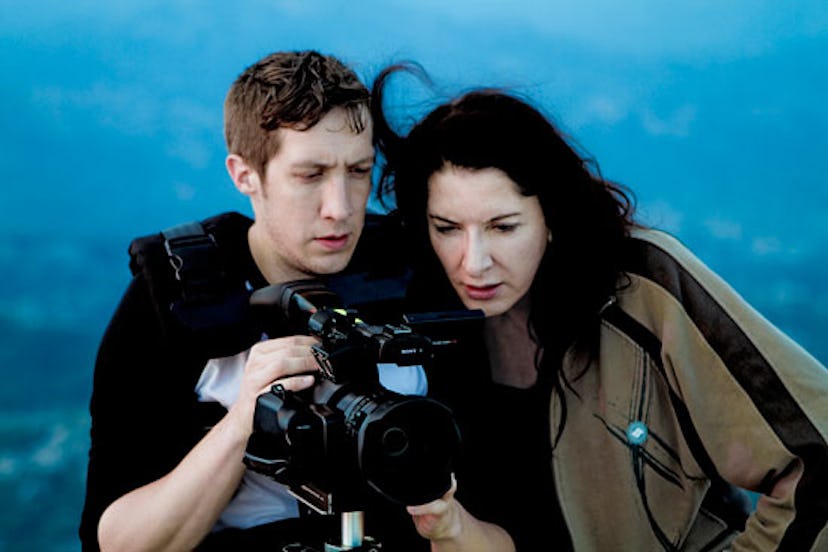Film Studies: Marina Abramović
"My first idea was to get David Lynch," says Marina Abramović, about the process of finding a filmmaker to direct a titular documentary about her 2011 MoMA retrospective The Artist is Present. The hitch? She'd...

“My first idea was to get David Lynch,” says Marina Abramović, about the process of finding a filmmaker to direct a titular documentary about her 2011 MoMA retrospective The Artist is Present. The hitch? She’d never even met the Blue Velvet director. “I tried several times to meet him, but it never worked. Then I met Matthew, and from the very first moment I realized how obsessive he is and I knew it would work.” After a chance encounter with his producer, Abramović got clued in to filmmaker Matthew Akers’ borderline-obsessive style that led him to live on an aircraft carrier in the Persian Gulf for six months for the 10-hour PBS documentary series Carrier. He followed that up with a year on the road trailing the Big Apple Circus for PBS’s Circus.
“This is commitment, this is where you really believe in something, and this is really important to me,” admits Abramović, who then proceeded to shoot 700-plus hours of footage with Akers over the next year. Probing into her bathroom, bedroom, and beyond , The Artist is Present offers a penetrating look into her process. Abramović is so obsessed with the footage now — and everything that’s not in the doc — that she wants to make three more films and/or enlist a gallery to play all 716 hours of straight footage so “People can come and watch any part they want,” she says. “Maybe they will do it after I die.” In the meantime, Akers gave us his version of events as they happened on the ground with his engimatic subject.
Describe what it was like when you first met her. I knew her work because I’d actually studied her in art school. At first I wasn’t interested [in the project] because I was so exhausted. But within the first five minutes of meeting her up at her workshop she immediately charmed me. One of the reasons she felt I was right was she saw my ability to endure thresholds of pain as a cameraman, standing and following somebody or holding your body in contorted positions for hours and hours. I think I pushed her to her limits often. Every time she thought I was done I’d just keep shooting to the point where I wore her out. I knew I’d probably never break her, but I knew for sure she’d never break me.
Did you feel the same way about her work? She’s the real deal. She puts in the time. Not just anyone can sit there eight hours a day for three months. I’d never been to any of her performances, so I had a degree of skepticism. I vocalized some of that to her, too. I don’t know if that was fearlessness on my part, but I was immediately telling her, “First of all, you have to give me total access. Second, I’m not sure what I think about your work.” She was totally unfazed by that. She liked that I was skeptical, because she’d been faced with that “Why is this art?” question her whole career.
Was there a vanity to that response in a way? There was some vanity to it. We don’t talk about it in the film, but she was in the midst of a divorce at the time. And now here’s a thirty-something male that’s willing to give up a year of my life and spend all this time with here, so I think that was attractive to her.
Was there any other aspects of her life or the performance that got left on the cutting floor? There were some scenes I was prevented from filming that were amazing stories. I heard the museum guards were having this pretty profound connection to the re-perfomers while guarding them. The guards stand there guarding inanimate objects, but suddenly they’re guarding people standing motionless for hours and it ignited this kindred spirit between everyone. The guards felt like they were protectors, but also that they were participating in the work. All this magical stuff started happening, and I started talking to the guards offline about the experience, but [MoMA] didn’t want the guards to be the spokespeople for the museum. Another amazing thing was that the guards would go home and come back on their off-days and just wait in line and sit with [Marina].
Did you ever worry you weren’t ever getting the real Marina, that she was always performing? That was the biggest challenge to me. I was filming her easily 12 hours a day, and when we weren’t shooting I was hanging out and figuring out what was going on next. She has multiple personas like we all do, but hers seem intensified. Here’s the ultimate lesson I learned: While I was skeptical of never seeing the real side of her, I realized that all of the sides of her are just as real, and I didn’t learn that until late into the edit. I still remained skeptical, wondering “Did I ever really see the real Marina?” But when I edited I realized that it doesn’t really matter. What matters is that the work I witnessed had a profound effect on people and embodies profound concepts and ideas.
Photo: Jeff Dupre/ Courtesy of HBO Documentary Films & Music Box Films.